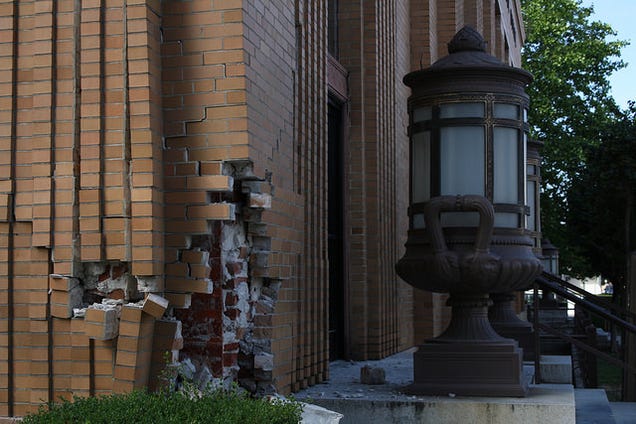Katharine Trendacosta

The European Space Agency's Sentinel-1A was launched just last year, and it's already proving its importance as the first satellite actually optimized to target areas of seismic activity. The proof is in the pudding. In this case, the pudding was the August 2014 San Francisco area earthquake.
Image credit: Napa Post Office Following the August 24th, 2014 Earthquake by Matthew Keys/flickr/CC BY-ND 2.0
An EOS article on the satellite lays out in detail everything the mission is doing to revolutionize earthquake monitoring. Sentinel-1A is outfitted with interferometric synthetic aperture radar (InSAR), which sends out pings of microwaves to the surface of the Earth. The strength and phase of the waves are reflected back to the satellite. The strength of the waves creates a map of the terrain, and the difference in the phases from before and after an earthquake can measure the shift along a fault down to the centimeter.
Sentinel 1-A's biggest test was the 6.0 earthquake that hit the San Francisco area on August 24th, 2014. Explain John R. Elliott, Austin J. Elliott, Andrew Hooper, Yngvar Larsen, Petar Marinkovic, and Tim J. Wright write in EOS (internal citations omitted):
The earthquake shook just weeks after Sentinel-1A had reached its final operational orbit and was the first geophysical event the satellite caught with both before and after scans. The event proved to be a powerful demonstration of the satellite's capabilities, revealing not only the deformation that occurred due to the earthquake itself but also the further slow, shallow fault motion in the weeks following the quake.
The earthquake slipped mainly along a previously partly mapped portion of the West Napa Fault zone, an area thought to store a small component of the potential seismic energy through this part of California. The first interferogram created by Sentinel-1A shows that the eastern side of the rupture moved about 10 centimeters in a southeastward direction, matching surface observations by scientists from the University of California, Davis, and the USGS.
Typically, ground motions in California follow strike-slip patterns, in which different regions of crust slide past each other along the fault. However, away from the fault trace, particularly near the ends of the rupture, significant vertical motion can also deform the ground.
Sentinel-1A reveals all this motion in great detail. The small surface displacements measured in the interferogram agree with the small offsets measured in the field by geologists surveying the fault rupture, who found displacements in roads and curb stones of about 10–20 centimeter.
All the data collected by Sentinel 1-A is expected to be processed by mid-2015. And, for the first time for a radar mission, the UK Natural Environment Research Council's Centre for the Observation and Modelling of Earthquakes, Volcanoes and Tectonics (COMET) will provide the entire research community with the processed InSAR results for all the tectonic and volcanic regions of the planet. Soon, only a day and half will pass between a major tectonic event and the acquisition of data from the satellite. COMET will post it online in near-real time, so that scientists and responders in the field will have access to it.
This open-sourcing of data could be a major boon to those responding and reporting on the natural disasters. Beyond disasters, the massive amount of data the mission will collect — the plan is for the mission to last 20 years — will change how we see the planet and the effect of volcanic and tectonic activity.
Read more about the data collected on the October 2014 earthquake here.
http://io9.com/how-a-satellite-is-transforming-earthquake-monitoring-1686700565
--
__._,_.___

No comments:
Post a Comment